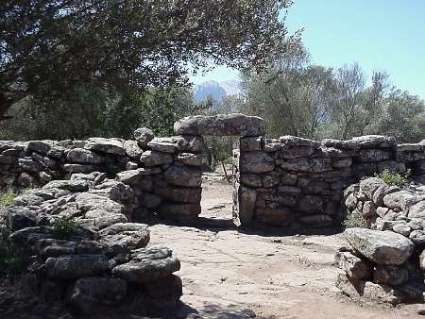 |
 |
 |
 |
There are more than 7,000 nuraghi in Sardinia, the villages of a civilization that lived on the island from about 1800 BC until 500 BC. The villages consisted of towers, fortresses, dwellings and religious sites, but very little is known about the nuraghic people. More than 1500 bronze figures were found in the tombs and near holy wells. The photo at left shows an entrance to one of the most well-preserved nuraghic villages of more than 70 dwellings, at Serra Òrrios, dating from the twelfth to tenth centuries BC. |
|
Here, you can see the Tomba di Giganta (Tomb of Giants) at Sa Ena 'e Thomes, erected in the shape of a bull's head, as seen from above, to honor the Bull God. Like many prehistoric monuments, this tomb is located on private land. Visitors have to be sure to close the entrance gate upon leaving, so they don't let the sheep out. |
|
|
|
|
|
On Shrove Tuesday, and the last night of Carnival, the Mamuthones and Issohadores come out. We were lucky to see them in the summer instead, during a visit to an inland village called Siniscola. The Mamuthones wear black tragic masks and shepherds' clothes, with bells tied on their backs. They walk with a somber and rhythmic pace, followed by the dashing Issohadores, who lasso spectators along the way to bring them to the traditional Sardinian circle dance. |
|
|
One of the Issohadores
|
|
|
Porcheddu, suckling pig, is a favorite local specialty in Sardinia. Ordinarily, it is roasted only for celebrations, and most restaurants need advance notice to serve it. Our hiking tour through the mountains included a Sardinian meal of almost countless courses, of which the main attraction was the pig shown at left. |
|
|
|
|
|
Santa Maria Navarrese got its name from the small church around which the town developed. According to local legend, the principessa, daughter of the king of Navarra, was involved in a shipwreck, but returned safely home. In gratitude, during the eleventh century, she built the church, where a thousand-year old olive tree still stands. While we visited, on the eve of ferragosto, Assumption Day on August 15, there was a celebration in the harbor. In this ceremony, a procession of townspeople take the Madonna from the church to the marina, onto the boat, out to the sea and later returned to the church. Many citizens and clergy, including children dressed in traditional costumes, walked down from the town to a waiting boat. At right, the two men are playing launeddas, an ancient three-pipe instrument originally played by shepherds. The tone it emits is uninterrupted, like a bagpipe. The instrument is so old that there are nuraghic figurines of people playing launeddas. You can see the Madonna awaiting the voyage behind the musicians. |
|